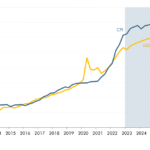Introduction
As we enter August 2024, the UK economy stands at a critical juncture, influenced by a complex interplay of domestic policies, global economic trends, and market dynamics. This comprehensive analysis explores the key factors shaping the UK economic outlook, providing insights into growth prospects, inflation trends, labor market developments, and sectoral performance. Understanding these elements is essential for businesses, investors, and policymakers navigating the current economic landscape.
1. Economic Growth Prospects
1.1 Current Economic Conditions
The UK economy has shown signs of recovery from recent disruptions, with the latest data indicating a steady growth trajectory. According to the Office for National Statistics (ONS), the GDP growth rate is approximately 2.1% year-on-year. This reflects a stabilization following the economic challenges of previous years.
1.2 Growth Forecast for August 2024
Looking ahead, the UK economy is projected to continue its moderate growth through August 2024. Key drivers of this growth include:
- Consumer Spending: Consumer confidence is improving, leading to increased spending. Retail sales data indicate a rebound in consumer activity, supported by rising disposable incomes and reduced inflationary pressures.
- Business Investment: Increased business investment is expected, particularly in sectors such as technology and infrastructure. This investment is likely to be fueled by favorable government policies and a stable economic environment.
- Government Stimulus: Recent fiscal measures, including infrastructure spending and tax incentives, are designed to stimulate economic activity. These policies are expected to contribute positively to growth in the coming months.
2. Inflation and Interest Rates
2.1 Inflation Trends
Inflation has been a significant concern in recent years, driven by global supply chain disruptions and rising energy costs. However, recent trends suggest a moderation in inflationary pressures. As of July 2024, the Consumer Price Index (CPI) stands at approximately 3.0%, down from higher levels earlier in the year. Key factors influencing this trend include:
- Energy Prices: Stabilization in global energy markets has helped to moderate energy costs, contributing to easing inflation.
- Supply Chain Improvements: Ongoing improvements in supply chains are reducing cost pressures on goods and services.
2.2 Interest Rate Outlook
The Bank of England’s monetary policy will play a crucial role in shaping the economic landscape. The central bank has adopted a cautious approach to interest rates, aiming to balance economic growth and inflation control. Key considerations for the next six months include:
- Potential Rate Adjustments: The Bank of England may implement gradual interest rate adjustments based on economic data. A modest increase in rates is possible if inflationary pressures persist, but the approach is likely to be measured to avoid stifling growth.
- Monetary Policy Strategy: The central bank’s strategy will focus on managing inflation while supporting economic recovery. The outlook for interest rates will depend on the evolution of inflation and economic growth.
3. Labor Market Developments
3.1 Employment Trends
The UK labor market has shown resilience, with the unemployment rate falling to around 4.5%. Key trends and projections include:
- Job Creation: Employment growth is expected to continue, driven by sectors such as technology, healthcare, and green energy. The recovery in the hospitality and retail sectors will also contribute to job creation.
- Wage Growth: Wage growth has been robust, with average earnings increasing in response to a tight labor market. However, wage growth may moderate as the labor market stabilizes.
- Skills Shortages: Certain sectors are experiencing skills shortages, particularly in technology and engineering. Addressing these shortages through training and immigration policies will be crucial for sustaining economic growth.
3.2 Labor Market Challenges
- Remote Work Trends: The shift towards remote and hybrid work models continues to impact various sectors. Businesses will need to adapt to these changes to attract and retain talent.
- Productivity Improvement: Enhancing productivity remains a key challenge. Investments in technology and workforce development will be essential to boost productivity and support long-term economic growth.
4. Trade and International Relations
4.1 Post-Brexit Trade Arrangements
The UK’s post-Brexit trade arrangements are evolving, with new trade agreements and regulatory frameworks coming into play. Key developments include:
- Trade Agreements: The UK has been negotiating trade agreements with various countries and trading blocs. These agreements aim to facilitate trade and reduce barriers for UK businesses.
- Customs and Border Controls: The implementation of new customs and border controls will impact trade flows. Businesses will need to adapt to these changes to ensure smooth operations.
4.2 Global Economic Influences
- Geopolitical Tensions: Global geopolitical tensions, including trade disputes and conflicts, may impact the UK’s international trade and investment.
- Economic Slowdown: A potential economic slowdown in major economies, such as the US and China, could affect global demand for UK exports. Monitoring global economic conditions will be important for anticipating potential impacts on the UK economy.
5. Housing Market Trends
5.1 Current Housing Market Conditions
The UK housing market has demonstrated resilience, with house prices remaining relatively stable. Key trends include:
- Price Stability: House prices have stabilized following previous fluctuations. Demand for housing remains strong, particularly in urban areas and regions with high employment growth.
- Supply Constraints: The housing supply remains constrained, contributing to price stability. Increased construction activity and housing developments are expected to alleviate some of these constraints.
5.2 Future Outlook
- Interest Rate Impact: Changes in interest rates will influence mortgage rates and housing affordability. A rise in interest rates could moderate housing market activity.
- Government Initiatives: Government policies aimed at supporting home ownership and increasing housing supply will play a role in shaping the housing market outlook.
6. Sectoral Insights
6.1 Technology and Innovation
The technology sector continues to be a major driver of economic growth. Key developments include:
- Investment in Technology: Increased investment in technology and innovation is expected to drive growth in sectors such as fintech, artificial intelligence, and cybersecurity.
- Start-ups and Scale-ups: The UK remains a hub for start-ups and scale-ups, with supportive policies and access to venture capital fueling growth.
6.2 Green Energy and Sustainability
Sustainability and green energy are becoming central to economic policy. Key areas of focus include:
- Renewable Energy Investment: Investment in renewable energy sources, such as wind and solar power, is expected to increase as the UK aims to achieve its climate targets.
- Green Technologies: The development and adoption of green technologies will be crucial for reducing carbon emissions and supporting sustainable economic growth.
7. Consumer Behavior and Spending
7.1 Consumer Confidence
Consumer confidence has been recovering, leading to increased spending. Key factors influencing consumer behavior include:
- Economic Outlook: Positive economic prospects and improving job market conditions contribute to higher consumer confidence.
- Spending Patterns: Consumers are increasingly prioritizing experiences and discretionary spending, impacting sectors such as travel, dining, and entertainment.
7.2 Retail Sector Trends
- E-commerce Growth: The growth of e-commerce continues to reshape the retail landscape. Retailers are focusing on enhancing their online presence and investing in digital capabilities.
- Sustainability Preferences: Consumers are increasingly prioritizing sustainability and ethical considerations in their purchasing decisions, influencing retail strategies.
8. Conclusion
As August 2024 unfolds, the UK economy faces a mixed but cautiously optimistic outlook. Modest growth is expected, supported by consumer spending, business investment, and government policies. However, challenges such as inflation, interest rate adjustments, and global economic influences will require careful management. Key sectors, including technology, green energy, and retail, will play pivotal roles in shaping economic outcomes.
Businesses, investors, and policymakers should remain adaptable and informed, leveraging opportunities while addressing potential risks. By staying abreast of economic trends and developments, stakeholders can make informed decisions and contribute to the UK’s economic resilience and growth.


